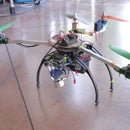Introduction: Retro Tech Shades
My friends John, Jared and I were challenged to design, prototype, and make a piece of wearable technology. We came up with a product, a pair of interactive wayfarers sunglasses. They have a photo-resistor right above the nose to detect the amount of light in the area. If it starts too get dark, it turns on the strip of neo-pixels to act as a flashlight. There is also a button on the side of the shades to control the position of the servo.
We also want it to be known that this project was designed, prototyped, and produced in 4 school days. This was not originally meant to be a work of art.
Step 1: Materials
- 1 Arduino Uno http://www.adafruit.com/product/50
-1 Half sized bread board http://www.adafruit.com/products/64
-5 Neo Pixels from Adafruit http://www.adafruit.com/products/1260
-2 servos http://www.adafruit.com/products/169
-1 Pushbutton (tact switch) http://www.adafruit.com/products/1490
-2 10kohm resistor http://www.radioshack.com/product/index.jsp?produc...
-Wire (preferably multiple different colors) https://www.sparkfun.com/products/8022
-1 photo cell http://www.adafruit.com/products/161
-Wood Glue/Hot Glue/Two Part Epoxy
-Zip ties (optional)
-Wood/Plastic (what the sunglasses will be made out of)
Step 2: Laser Cutting
The first step is to cut out all of the pieces you will need to create your shades. Begin by designing your frames. We used Rhino but you can use any design software you prefer. Make sure to measure the thickness of the wood or plastic you will be laser cutting so that you can account for that when creating the slots on your frames. Also make sure that the top piece of your frame is thick enough to hide the neo pixels once they are attached.
In our files, the plastic we used was .125 inches thick, so the tabs are that size.
Step 3: Assembling the Frame
When putting your frame together I suggest using wood glue or two part epoxy because it will hold the best. If you are using two part epoxy and plastic make sure to sand the faces of the pieces you are gluing, so the epoxy can stick. I definitely would not suggest using hot glue, it will hold for a while but if you are taking it on and off your head a lot the joints start to fall apart. And make sure to mix the 2 part epoxy well. Also, we used a bead or 2 of hot glue to hold the frame while the 2 part epoxy was setting up. Work smarter, not harder. We ended up 3D printing new servo arms because ours broke and we did not have access to a laser cutter.
Step 4: Designing the Circuit
The circuit needs 2 input pins and 3 output pins , plus 5v and ground, for this setup. Here is the circuit diagram we made http://123d.circuits.io/circuits/400666-shades-circuit (in this circuit, the transistor represents the neo-pixel strip). Start by putting everything on a bread board to make sure everything works and once they do move the components onto your sunglasses. Keep in mind you may end up needing an extra battery pack for your neopixels so that there is enough power for the servos.
Step 5: Attaching Servos and Servo Arms
Before gluing the servos on, make sure they are pointing down, so the arms will rotate out and away from the frame. Also, when putting the servo arms on to the servos, make sure that they are spun all the way in one direction, so they can only spin outwards, so that the lenses don't break.
Next, you should glue the eye covers onto the servo arms, so you have actual shades now.
Step 6: Glue the Neo Pixels on to the Frame
Don't just glue the neo pixels straight on, if you do they will fall off almost immediately. You need to sand the area where the neo pixels will be, so the glue sticks to the wood/plastic. If you have the patience of a tree("I am Groot."), go ahead and use 2 part epoxy to glue the neo pixels on. But we just used hot glue, and it works. Also, we filled in the squares in front of the neo pixels, because light shines through hot glue fine, and it helped stick the neo pixels in place.
Step 7: Soldering
When soldering the neopixels make sure that you have all of the connections going the right way if you don't you may end up ruining your neopixels. Also make sure to solder on wires long enough to reach your Arduino. Soldering all of the other components should be fairly strait forward. With the servo we used break away male header pins so that you could easily detach the servos but it is not necessary.
Step 8: The Code
We set up the code so it opens and closes the lenses when you press the button, the neo pixels turn on when it starts getting dark, and the neo pixels turn off when it gets brighter again. If you want, you can write your own code, but if not, here is a link to our code:
Step 9: Finishing Touches
By now you should have a complete and functioning pair of RetroTech Shades. However, feel free to change, add or subtract things from the design as you see fit. We think the servo wires actually look good when glued on to the top of the earpieces of the frames. Also, we figured the neo pixel wires looked good there too, but if the non symmetry of them being only on one side bothers you, you can figure out something else. Feel free to leave suggestions and comments below so that we may improve the design!

Participated in the
Make it Glow!

Participated in the
Microcontroller Contest

Participated in the
Tech Contest














